Michelangelo Pistoletto is changing the world. And no, it can no longer be called a mere suggestion. We only need to look back at yesterday, at this week, at the last month, in fact at the artist’s entire life. Let us remain, however, in the more recent past and talk about yesterday, when the artist’s new exhibition, La Pace Preventiva, was officially opened in the Lombard capital, at Palazzo Reale, the main exhibition hub of the city centre, for many centuries the seat of the government of Milan, of the Lombard-Venetian Kingdom and then royal residence until 1919. As can be gathered from the title, Pistoletto once again places his art in a profound relationship with global society, touching with creative and reflective tones on the dramatic theme of the wars and conflicts of our time. But he does so offering a different vision, moving from the Bush doctrine of ‘preventive war’ – considered an attempt to repel or defeat an offensive or invasion perceived as inevitable, or to gain a strategic advantage in an imminent war even before the threat materialises – to ‘preventive peace’. Hence, the name of his new exhibition project, which does not stand as a mere retrospective exhibition, but as a spark to ignite reflective awareness in the viewer. Pistoletto, in fact, places the visitor in front of themselves, using his Mirror Paintings, the Third Paradise and the Mediterranean Table to shape this introspective process. The artist’s intuition does not stop there: the Labyrinth, a key work in the exhibition, goes beyond the role of installation work to become the trace of an extended artistic itinerary within the Sala delle Cariatidi. The work is the result of the progressive unrolling of corrugated cardboard arranged over the entire surface of the exhibition area as to accommodate some of Pistoletto’s most emblematic works. Visitors to the exhibition must therefore necessarily follow a winding and disorienting path as they walk through the labyrinth; in this laborious contraption of art, at every fork in the road they must necessarily choose the route to take in order to reach the other works on display, pause in front of them and reflect on their existence. As was the case last night, when leaving the installation each visitor takes with them the memory of an experience rich in imaginative content and practical information, but also the awareness of having completed a tangible exercise, effective in reflecting on how to escape from the labyrinth of everyday reality and establish “Preventive Peace”.
The exhibition, organisation and openings
Pistoletto’s new exhibition will run from today – Thursday 23 March – to Sunday 4 June 2023. Promoted by the Municipality of Milan Culture, Palazzo Reale and Cittadellarte – Fondazione Pistoletto in collaboration with Skira, the exhibition project is curated by Fortunato D’Amico and is part of Milano Art Week (11-16 April 2023), the widespread event coordinated by Milan City Council’s Culture Department, in collaboration with miart, which networks the city’s main public institutions and private foundations dedicated to modern and contemporary art with a collective programme of exhibitions and activities. The exhibition The Preventive Peace itself extends with installations in the City of Milan’s three scientific museums, i.e. the Natural History Museum, the Planetarium and the Civic Aquarium, which will host a series of conferences on the subject of the exhibition. Peace thus becomes the leitmotif of a cultural plan carried out within the social labyrinth, which helps avoid uncertainty when faced with the crossroads of decisions and take the road of harmony instead of the one that leads down the path of contrast and conflict.
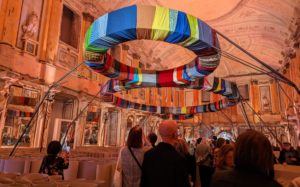
A moment of the opening. Photo by L.D.
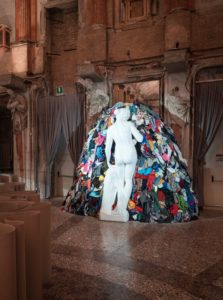
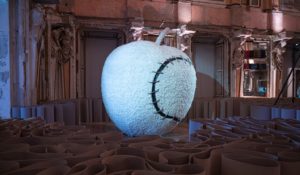
The Venus of the Rags and The Reintegrated Apple. Photo by Daniela Pellegrini.
From Picasso to Pistoletto
Seventy years ago, in 1953, in the very Sala delle Cariatidi still wearing the signs of the destruction caused by the Second World War, Pablo Picasso exhibited his large canvas Guernica; in the context of the pictorial story, we can glimpse the head of the Minotaur, the same monster that dominates the scene of today’s labyrinth .In 1961, the Spanish artist drew the Dove of Peace, the same dove that Vinci’s Secondary School student Manish Paul adopted for the work he created as part of the project Educating to Peace: Leonardo, Picasso Pistoletto¹, conceived and curated by teacher and Rebirth/Third Paradise ambassadress Patrizia Vezzosi since 2103. The educational initiative, included in the framework of the regional project Toscanaincontemporanea2013, combines formative training and creative workshop aspects, activating an experimental path of education to image as a tool for active citizenship: through Leonardo, Picasso and Pistoletto, the students understand that the necessary premise for building peace among peoples is the recognition of the universal value of the human being, and they communicate this to others, in particular to their peers, with contemporary languages. The work has then become the logo for the exhibition, as can be seen in the poster below.
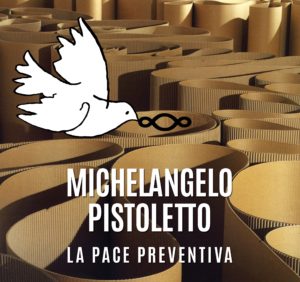
From the artist to society
If in terms of content and context this exhibition is of absolute authority, the response from the public was no less significant: last night, even Milan’s Duomo watched in curiosity as the long queue of people waited anxiously to enter the Sala delle Cariatidi for a first look at the exhibition. But signals arrived in fact from all over the world: this week, the Sentiero Rebirth Path flash mob has been held globally, an event conceived by Michelangelo Pistoletto “against all monstrosities caused by man. All of them, none excluded”. In numerous cities across Italy and the planet, hands have been joining with the strength of peace and hope. Performative moments that seem to accompany in parallel the artistic narrative of The Preventive Peace. The media too grasped the social importance of the exhibition, as testified by the large attendance at the morning press conference.
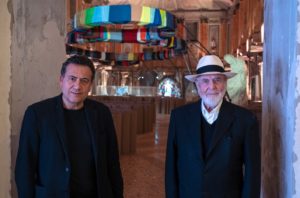
Fortunato D’Amico and Michelangelo Pistoletto.
Photo by Daniela Pellegrini.
The presentation
The official presentation of the exhibition was at 11.00 am at Palazzo Reale, with the artist himself highlighting its contents. The other speakers included Fortunato D’Amico (curator of the exhibition project), Tommaso Sacchi (culture councillor for the City of Milan), Domenico Piraina (director of Palazzo Reale) and Massimo Vitta Zelman (president of Skira). Sacchi began by thanking Pistoletto for “his art full of meaning, so strong and disruptive, which will touch some of Milan’s cultural landmarks”. According to him, in fact, the exhibition will help the city tell the story of the synergy between the art institutions that are part of Milan’s cultural heritage. “Pistoletto,” he added, “is a great protagonist of the art of our planet, and he has created iconic signs and productions of our time that have become symbols of a collective history”. His words were echoed by those of the museum director, who identified Pistoletto not only as an artist, but as an ambassador of Italy to the world. Piraina then illustrated the change of perspective in the exhibition, referring to a Latin sentence by the Roman writer Vegetius: “Pistoletto reverses the meaning of ‘Si vis pacem para bellum‘ (‘If you want peace, prepare for war’, editor’s note), inviting the public to work in a practical sense for preventive peace. And many works in the exhibition bear witness to this. It is an optimistic exhibition,” he said “the artist does not merely denounce a problem, but argues how it can be solved. An example of this can be found in his Labyrinth: we do not know what the way out is, but we know what escape routes are already blocked; so we do not choose the wrong path, but rather try to take others”. After Massimo Zelman, president of Skira, spoke (“Our role honours us, I am happy to renew the partnership that binds us to Palazzo Reale, and I thank Pistoletto, a long-standing friend, for the wonderful exhibition he has created for the Sala delle Cariatidi”), Fortunato D’Amico, the curator of the exhibition project, gave his vision of Pistoletto (“The artist has gone beyond the aesthetic tracks of art, because for him, art also stems from ethical principles; he cannot be considered an individual artist because his works are the result of relationships with other people”) and then contextualised the contents of the exhibition: “There are over 100 conflicts in the world, so preventive peace is a current theme. It is not deliberately established when there is already a war going on, but before;” he specified, “when art becomes part of contemporary society, it takes on social responsibility and tells us that we have the power to change”. Michelangelo Pistoletto spoke last, offering an insight into his artistic history, touching on and exploring the peculiarities of a series of his works – not only those in the exhibition – ranging from the Third Paradise to the Minus Objects to the Mirror Paintings.“What we see reflected in the Mirror Paintings in the exhibition is infinite and constantly renewed,” he emphasised, “the result is a continuous combination that makes things possible: it is creation”, a consideration leading directly to his latest book: “To have arrived at the formula of creation is quite an achievement for us human beings: and it was me finding it,” he said, smiling, “we have found the formula through the image: art is the image of things, art has combined common life, artificial society, since natural life continues independently; we have created the artificial, but without art there would be no artificial world, the whole process from religions to politics. It is a combination of human phenomena”.
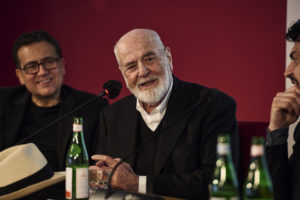
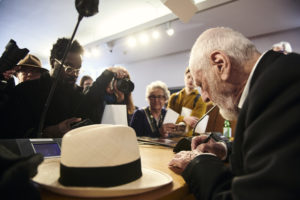
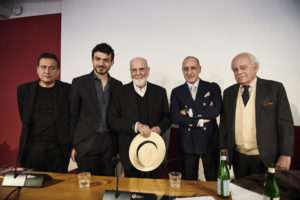
The press conference. In the picture, from the left: Fortunato D’Amico, Tommaso Sacchi, Michelangelo Pistoletto, Domenico Piraina and Massimo Vitta Zelman. Photo by Damiano Andreotti.
The comment of the mayor of Milan
The first citizen of the Lombard capital was also enthusiastic about the exhibition project: “The sparks of thought ignited by art on reality make people freer,” commented Giuseppe Sala, “an inexhaustible source of energy fuelled by major cultural initiatives such as the exhibition “The Preventive Peace”, dedicated to the visionary gaze of Michelangelo Pistoletto. New horizons on the present will be open to all visitors to Palazzo Reale. Between 23 March and 4 June 2023, a labyrinth will occupy the Sala della Cariatidi, to further emphasise the dimension of the enigma in the face of the horror of war. Despite millennia of devastation, the world pays a huge tribute to gun violence. Such overwhelming hatred, like that inspiring Russia’s war against Ukraine, arouses feelings of confusion and discouragement. Michelangelo Pistoletto’s works are a light of hope in the night of humanity imposed by war conflicts. The projection towards justice of “The Preventive Peace” also gives greater prominence to Milan Art Week. A week dedicated to art, the key language for disseminating, through beauty, the values dearest to our city: freedom, democracy, and the protection of fundamental rights. Principles at the basis of peaceful coexistence between peoples and individuals,”concluded the mayor, “as Pistoletto’s art tells us in a visionary way”.

